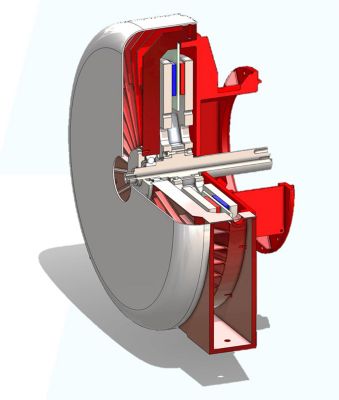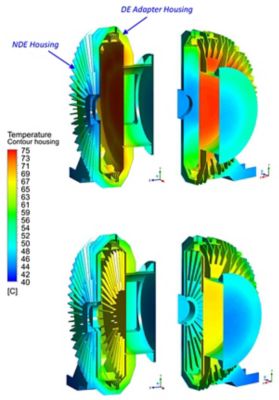-
-
Access Free Student Software
Ansys empowers the next generation of engineers
Students get free access to world-class simulation software.
-
Connect with Ansys Now!
Design your future
Connect with Ansys to explore how simulation can power your next breakthrough.
Countries & Regions
Free Trials
Products & Services
Learn
About
Back
Products & Services
Back
Learn
Ansys empowers the next generation of engineers
Students get free access to world-class simulation software.
Back
About
Design your future
Connect with Ansys to explore how simulation can power your next breakthrough.
Free Trials
ANSYS BLOG
February 15, 2024
Infinitum: Motors Designed for a More Efficient and Sustainable Future
There are billions of electric motors out there making the world turn — and collectively they consume more than half of the world’s electricity today, most of it coming from emission-heavy, coal-fired power plants. That’s why any improvement in motor efficiency could significantly advance global decarbonization efforts and accelerate the transition to electric vehicles.
With that in mind, Infinitum, a Texas-based manufacturer, developed a next-generation motor that is lighter, uses less energy, and produces fewer emissions than traditional iron core motors.
With the help of Ansys Fluent and Ansys Maxwell software, accessed through the Ansys Startup Program, they succeeded. The company says its air-core technology, which is used across its product portfolio, produces motors that are 50% smaller and lighter, nearly 20% less carbon intensive to manufacture, and 10% more efficient than conventional motors with the same power output.
Cutting Weight and Reducing Emissions
Printed circuit board (PCB) stator technology is at the heart of the air-core difference.
Stators are the stationary components in electric motors that create a rotating magnetic field when an AC current is applied to them. Most stators consist of laminated stacks of iron core and coils of insulated wire, typically copper, called windings.
Iron cores have been used since the electric motor was invented more than a century ago, but that doesn’t mean they’re perfect. For one thing, they’re heavy. And iron ore mining is not the most environmentally friendly process.
In addition, iron core stators are prone to performance problems, most notably core losses — energy losses associated with induced eddy currents and hysteresis — and also torque ripple — periodic variations in torque output — and cogging — an undesirable torque component that causes jerkiness in motion.
By removing iron cores and copper windings from the stator and replacing them with a patented PCB stator between two magnetic rotors, Infinitum increased their motor’s performance-to-size ratio, decreased weight, reduced the effects of torque ripple and cogging, and curbed eddy current losses. In this design, the magnetic flux travels between one rotor and the other without an iron core in its path, hence the air-core moniker. Eliminating iron and reducing the amount of copper in the motor (there’s still copper winding in the stator, where it is essential to functionality), equates to less resource use and diminished negative impacts from mining. Together, this translates to close to 20% fewer carbon emissions when making the motor.

Rendering of the high-efficiency, low-weight alternator
Quantifying the Losses
Because eddy currents generate heat — wasted energy that leads to lower efficiency — minimizing them in motors, generators, and transformers is essential. When Infinitum began developing their PCB stators, their internal design tool calculated that eddy current losses would amount to 126 watts (W). Testing, however, showed significantly higher losses of 330 W. To investigate this discrepancy, engineers turned to Maxwell.
Considering that eddy currents are generated nearest the magnet transition, Infinitum engineers used Maxwell to examine a simplified stator model, focusing on the interaction between the straight strands of a single copper coil and a magnet passing by at speed without compromising the fidelity of a full-scale stator.
Simulations in Maxwell clarified that eddy currents were primarily confined to the three central coil strands closest to the magnet transition and further affected by the size of the air gap between the coil and the magnet. By extrapolating simulation findings for all coils in a complete stator, Infinitum engineers determined that a proximity effect between neighboring strands in the coils accounted for the difference between the design and reality.
Solving the disparity between PCB stator modeling and testing allowed Infinitum’s engineering team to adjust the closed-form solution used by their internal design tool so that future tests would closely match the outcomes achieved in simulation.
Going With the Flow
Heat transfer, heat loss, and cooling are important considerations for any motor maker, but when your product is small yet powerful, the stakes are even higher. Infinitum uses Fluent for heat management simulation, including when it is designing custom air-core products for clients.
Recently, a leading company in construction and mining equipment asked Infinitum to develop a prototype of a high-efficiency, low-weight air-core alternator that could integrate with an existing generator, provide 20 kilovolt-amps (kVA) of power, and operate at a rate of 1500 revolutions per minute (RPM).
After using their in-house system to model a preliminary mechanical design that satisfied the electrical and interface requirements of the project, Infinitum engineers turned to Fluent to refine the first iteration air cooling system.
With uniform stator temperature and high efficiency as primary objectives, Infinitum set out to customize a design that would produce the requisite cooling through internal air circulation and the flow rate of a mechanically driven impeller in place to draw air out of the system. Engineers also evaluated the conductive cooling capabilities of a newly developed stator housing wall featuring scalloped contact areas—a design intended to offer more consistent cooling through conduction than could be achieved by a uniform but thinner contact area.

Housing temperature plot (left) and stator temperature plot (right)
Though Fluent simulations showed that overall stator temperatures were acceptably low at the start of the customization process, the initial impeller concept — based on prior Infinitum radial blade designs — induced an unacceptable decline in efficiency through windage losses. With 12 blades, a 390 millimeter (mm) outer diameter, and a depth of 42 mm, the first iteration impeller produced a flow rate of 700 cubic feet per minute (CFM). After engineers eliminated four blades, reduced the outer diameter to 290 mm and the depth to 30 mm, simulations showed the flow rate dropped to a more efficient 300 CFM. This interim impeller served through the cooling system’s next two iterations.
Housing fin arrangement and quantity also proved to be critical to the success of this system. Although stator temperature remained within expected limits after engineers modified the impeller, there was still a significant temperature differential between the drive end and non-drive end of the alternator housing. Engineers concluded that a lack of internal fins on the drive end housing prevented symmetric cooling. Simulations run after adding internal fins to the housing design showed a cooler and more even temperature gradient for both the stator and the housing.
While flow findings proved that the scalloped features of the housing wall successfully removed 28% of stator heat through conduction, designers added fins to the housing circumference to aid in further dissipation. This iteration also revealed that the profile of the external shroud was ineffective at channeling air to the housing fins and that the existing lower mounting features caused a secondary airflow obstruction for a portion of them. Further simulations confirmed that modifying the shroud profile to follow the fin outline and reducing the size of the mounting features remedied these issues.
To finalize the impeller design for internally powered flow and determine a recommended external flow rate, Infinitum conducted a mass flow requirement study using Ansys CFX and a simplified mechanical model of the cooling system.

Housing temperature without internal fins (top) and housing internal temperature with internal fins (bottom)
On this mass flow simulation model, the electrical connection boss and mounting feet were removed and a modified shroud based on computational fluid dynamic (CFD) results to direct air over the alternator housing took the place of the existing shroud attachment. In line with casting vendor specifications, the housing material was changed to grey cast iron, fin thickness was set to 6 mm, and basic wall thickness was set to 10 mm. With internal rotor motion set at 1500 RPM, the external flow varied between 100 and 400 CFM and the heat load varied from 100% to 130%.
By plotting and extrapolating stator temperature versus external air flow curves along with a system impedance curve, Infinitum determined the minimum operating point and a recommended operating range for their design. In response to these findings, an impeller with a 300 CFM flow rate was developed and fabricated with 3D printing for the prototype.
The modeling and testing capabilities of cutting-edge simulation software allow designers and engineers to experiment with limitless variation, unburdened by the numerous time and financial constraints of working with physical models. Aided by these advantages, Infinitum’s successful entrance into a specialized market, while still in its infancy, should serve as a testament to the value of digital engineering. The example Infinitum has set proves that it’s possible to make waves in an industry that hasn’t seen significant technological progress in generations and set a course toward solving some of the world’s hardest problems.
Learn more about the Ansys Startup Program, view eligibility requirements, software bundles, and success stories.